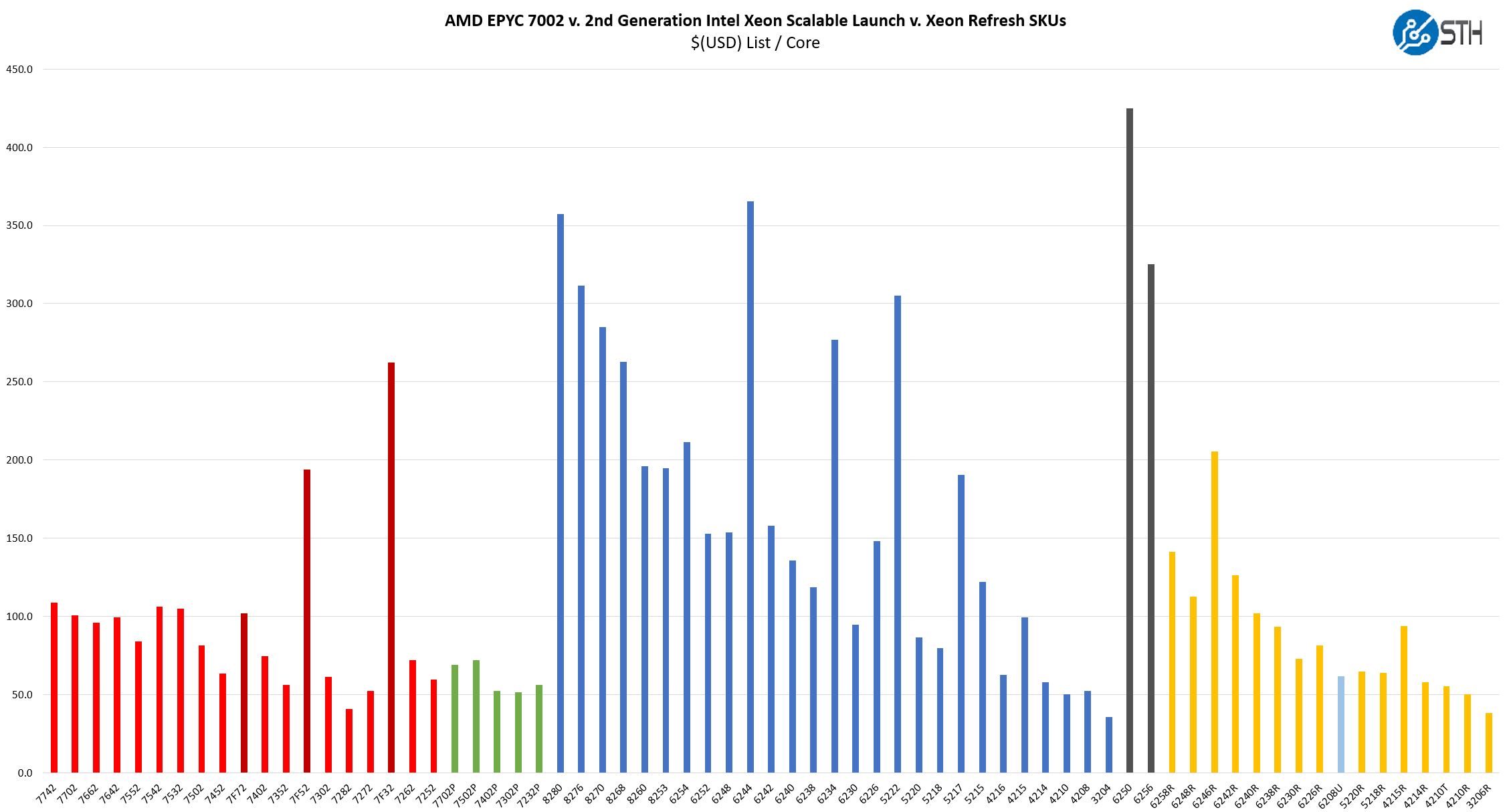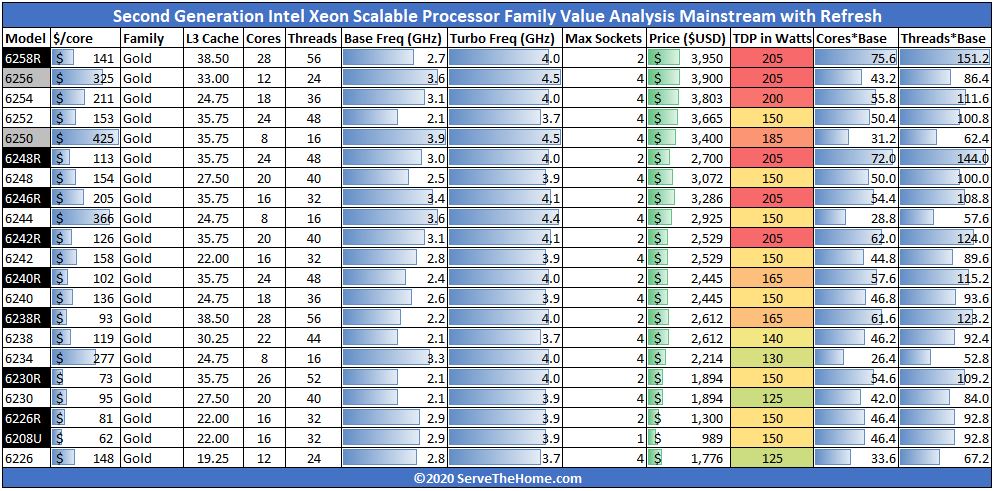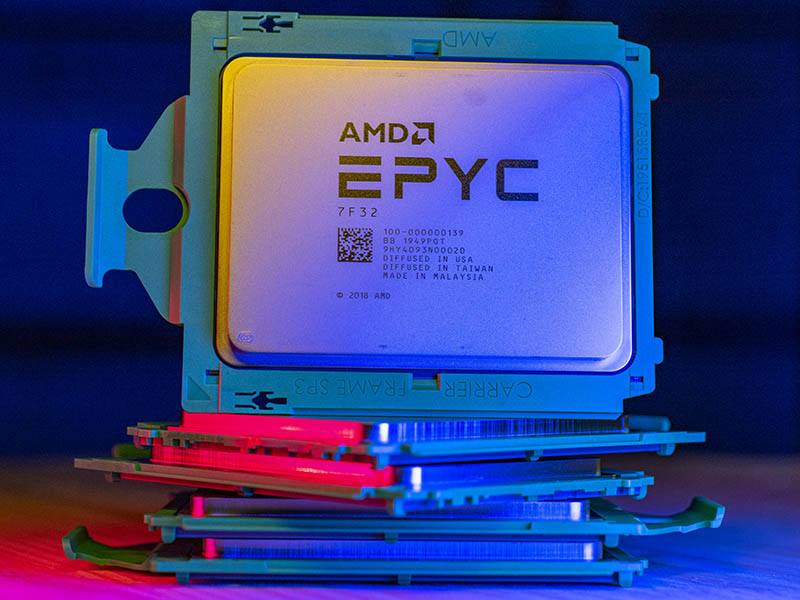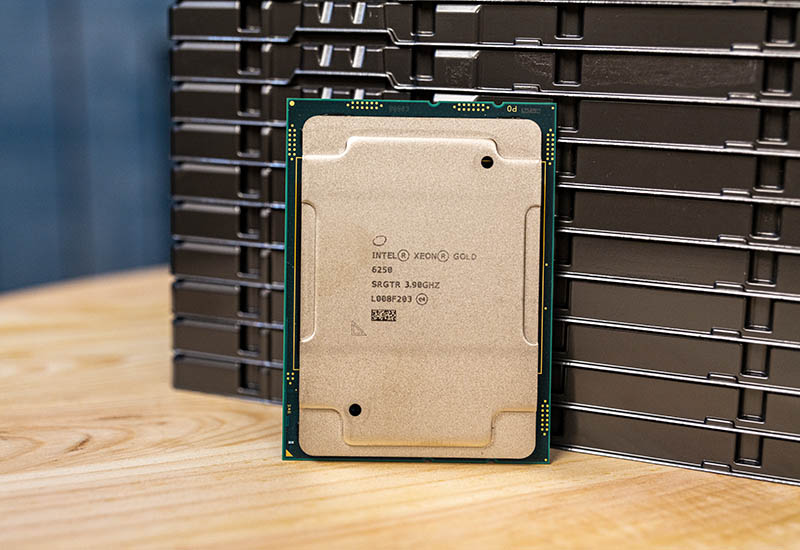Intel Xeon Gold 6250 Market Positioning
Thes chips are not released in a vacuum instead, they have competition on both the Intel and AMD sides. When you purchase a server and select a CPU, it is important to see the value of a platform versus its competitors. Here is a look at the overall competitive landscape:

We are going to dive into the impact of this chart next in our discussion of different competitive vectors.
Intel Xeon Gold 6250 v. Intel Alternatives
Here is the new Xeon Gold line including the refresh parts.

There are a few points that become clear very quickly. First, this is by far the highest $/core mainstream Xeon Gold part on the market now. It also has the highest clock speeds. We did not have a Xeon Gold 6244 to test, however, it is clear the Xeon Gold 6250 is on another level.
If you are in the market for an 8-core frequency optimized part, a ~$1200 premium for the Gold 6250 over the Xeon Gold 6234 to get 600MHz base and 500MHz turbo clocks along with another 55W of TDP headroom is going to make a lot of sense. In this market, that $1200 delta and the additional power and cooling costs will be negligible compared to software license costs.
We did not mention it thus far in this review, but there is a Xeon Gold 6250L high-memory part as well. There is no “M” SKU since 2nd Gen Intel Xeon Scalable M SKUs are discontinued. If one wants to utilize high-capacity DCPMM for ultra-fast local persistent storage or very large memory pools, then the Xeon 6250L is going to be the way to go. We did an Intel Xeon Platinum 8260L v 8260 performance check and found the standard and “L” parts performed similarly, so we would expect that to be the case here.
Intel Xeon Gold 6250 v. AMD EPYC 7002 “Rome”
Here is where things get interesting. As you saw in many of our benchmarks, AMD simply has a bigger chip at this point. The AMD EPYC 7F32 has 8 cores. While it runs at lower slightly clocks it also has more memory bandwidth, more PCIe I/O and massively larger cache structures. As a result, it is able to notch numerous wins against the Xeon Gold 6250. From the original “Naples” EPYC 7001 series launch in 2017 to “Rome” in 2019, AMD effectively was not competing with Intel in this market. Now, AMD has a very competitive chip in a compelling server platform.

While AMD may have a lead, one also must remember Intel has more components such as NICs and SSDs that can be bundled at a system level with CPUs to offset differences. Where perhaps the most intriguing deltas happen in this AMD v. Intel segment come down to the platforms. If you are simply adding a few DIMMs and a single SATA SSD to a server with a 10GbE or 25GbE NIC, the platforms do not matter as much. However, we need to take a look at what they offer.
These CPUs support Intel Optane DCPMMs for a different class of persistent memory and storage, albeit only up to 1TB of memory (4.5TB on the “L” variant.) Intel also has AVX-512 and VNNI (DL Boost) instruction advantages.

AMD has features such as supporting more, higher-capacity (non-L SKU), and higher-speed RAM, more PCIe lanes, and PCIe Gen4 support. If you need the more “scalable” two-socket platform, AMD simply has the more scalable dual-socket solution at this point. Intel also rationalized away a mainstream Cooper Lake Xeon platform so we are left waiting until Ice Lake to get more parity on the platform side.
At the same time, Intel is now thoroughly in the range where with smaller discounts it can offer a competitively performing part, at a close enough price to keep buyers who were considering switching. For incumbents, pricing for your offerings just needs to be “close enough” to avoid a mass exodus to your upstart competitor. Those discounts also range beyond just the CPUs and extend to storage, NICs, accelerators, and memory (DCPMM) as well.
For organizations that have standardized on a server platform such as the HPE ProLiant DL360 Gen10, many will work within bundling and find the Gold 6250 more than a compelling offering to provide frequency optimized cores within their existing server platforms. Not every organization will switch to an AMD EPYC platform if they are on Xeon platforms just to get a thousand dollars per CPU lower costs. There is more to this equation than just CPU costs.
Final Words
Overall, the Intel Xeon Gold 6250 does what one would expect. It offers eight frequency optimized cores into the market. While the cost per core is astronomical compared to contemporary alternatives, it is often dwarfed by the license fees imposed by software vendors. That makes the Xeon Gold 6250 the absolute right solution for certain licensing models. At the same time, if you are using open-source software and are not paying per-core license fees, then the Xeon Gold 6250 is the absolutely wrong solution. Perhaps Intel needs to have something like a “Xeon Igneous” line in the future as we are hitting the point that the frequency optimized parts are almost a distinct line where it becomes harder to differentiate Xeon Gold 5200 and Gold 6200 versus other Gold 6200 SKUs and this frequency optimized part.
Unlike previous releases, Intel now has competition. The AMD EPYC 7F32 is a strong competitor. Intel has a stronger position due to its portfolio breadth and incumbent position. In years past, it also had the only frequency optimized parts in the segment. As that is changing, we expect this segment to heat up in the future.




Looking forward to ZEN3
I really appreciate the high-frequency reviews. In my industry (semiconductors) simulation is (usually) a single-core process with very high licensing costs so money spent on faster cores is a no-brainer. While the proprietary software is obviously difficult to include in benchmarks I’d love to see Verilator benchmarks against an open-source core (e.g. Rocketchip)
There’s another facet that is perhaps too obvious to mention, but when the “long-pole” to tapeout are jobs that may run for 2-3 weeks, a high frequency part may get you there a week earlier. That’s real money, especially for a small company which, if it misses its window, might have to wait more than a month to get another slot at the fab.
so, roughly an 8700K with ECC support for $3400?
Seems tad….pricey. Might as well just include an Epyc mainboard and CPU at that cost
Review is written (seems to me) from the server oriented point of view. If someone needs workstation and does not need that much RAM, he/she can also try to use Threadripper or Xeon W line of CPUs. In the former case RAM max on 256GB, in later on 1TB. Both lines provide high frequency cores cheaper than compared/considered Epyc F/Xeon Gold.